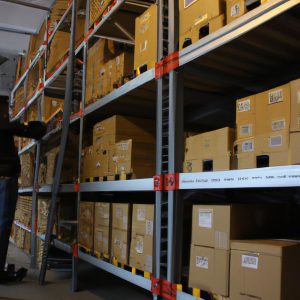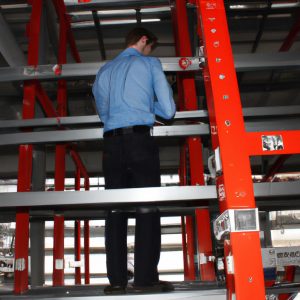Mezzanine Flooring: Enhancing Industrial Storage and Shelving

Mezzanine flooring is a versatile solution that has gained popularity in the industrial sector for its ability to enhance storage and shelving capabilities. By providing an additional level of space within existing buildings, mezzanine floors offer a practical way to maximize available square footage without the need for costly expansions or relocations. For instance, consider a hypothetical scenario where Company XYZ, a manufacturing facility dealing with limited floor space, decides to implement a mezzanine flooring system. This decision allows them to efficiently utilize vertical space and create new areas for storing inventory or setting up workstations.
In addition to optimizing storage capacity, mezzanine flooring also offers various advantages concerning organization and accessibility. With the installation of these elevated platforms, companies can effectively streamline their operations by categorizing products or equipment according to specific zones or departments. This systematic approach not only improves efficiency but also reduces the time spent searching for items, ultimately leading to enhanced productivity levels. Furthermore, mezzanines provide convenient access points through staircases or ramps, enabling employees to navigate easily between different levels and ensuring smooth workflow throughout the workspace.
Overall, mezzanine flooring serves as an indispensable tool in enhancing industrial storage and shelving systems. Its flexibility and adaptability make it suitable for various industries such as ware housing, manufacturing, retail, and logistics. Whether it’s used for storing inventory, creating additional office space, or setting up a production area, mezzanine flooring offers businesses the opportunity to efficiently utilize their available space and meet their specific needs. Additionally, mezzanines can be easily customized with features such as safety barriers, handrails, and lighting systems to ensure a safe working environment for employees. With its cost-effective and versatile nature, mezzanine flooring is a valuable solution for companies looking to maximize their storage capabilities without the need for extensive construction or relocation projects.
Benefits of Mezzanine Flooring for Industrial Spaces
Industrial spaces often face the challenge of limited floor space, hindering efficient storage and shelving solutions. One effective solution to maximize available space is the installation of mezzanine flooring. By providing an additional level in a warehouse or manufacturing facility, mezzanine flooring offers numerous benefits that enhance industrial operations.
To illustrate its advantages, consider the case of a large manufacturing plant grappling with inadequate storage capacity. With the implementation of mezzanine flooring, they were able to double their usable floor area without expanding their building footprint. This allowed them to efficiently store raw materials on one level while using the other for assembly workstations and finished goods. Consequently, productivity increased as workers had easier access to supplies and could complete tasks more effectively.
One major benefit of mezzanine flooring is its versatility. It can be customized to meet specific requirements and integrated seamlessly into existing structures. The flexibility provided by this modular system allows businesses to adapt their storage layout according to changing needs. Additionally, mezzanines are compatible with various shelving systems such as pallet racking or cantilever racks, further optimizing storage capabilities.
The introduction of mezzanine flooring also enhances safety within industrial spaces. By utilizing sturdy construction materials and adhering to relevant safety regulations, these platforms provide a secure working environment for employees performing tasks at elevated heights. Moreover, incorporating safety features like guardrails and non-slip surfaces reduces the risk of accidents and improves overall workplace well-being.
In summary, installing mezzanine flooring presents several compelling advantages for industrial spaces:
- Maximizes available floor area, enabling efficient utilization.
- Customizable design integrates seamlessly into existing structures.
- Enhances safety through compliance with regulations and incorporation of safety features.
- Provides an adaptable platform compatible with various shelving systems.
Considering these benefits drives home the importance of implementing mezzanine flooring in industrial settings where space optimization is crucial. In the subsequent section, we will explore the factors that businesses should consider when installing mezzanine flooring to ensure a successful and efficient implementation.
Factors to Consider When Installing Mezzanine Flooring
Transitioning from the previous section, which discussed the benefits of mezzanine flooring for industrial spaces, let us now delve into the important factors that need to be considered when installing such flooring. To illustrate these factors, we will consider a hypothetical case study of a manufacturing facility looking to optimize their storage and shelving capabilities through the implementation of mezzanine flooring.
Firstly, one crucial factor to consider is the load-bearing capacity of the existing structure where the mezzanine floor will be installed. The weight distribution and structural integrity must be carefully assessed to ensure that it can support both the additional weight of the new flooring system as well as any equipment or inventory that will be placed on top of it. For instance, in our hypothetical case study, engineers would conduct thorough assessments to determine if reinforcement or modifications are needed for the building’s columns and beams before proceeding with installation.
Secondly, safety considerations play an integral role in designing and installing mezzanine floors. This includes proper access points like staircases or elevators, handrails along edges to prevent falls, fire protection measures such as sprinkler systems or smoke detectors, and compliance with relevant building codes and regulations. In our example scenario, the manufacturing facility would prioritize employee safety by ensuring all necessary safety features are incorporated into their mezzanine design.
Thirdly, it is essential to evaluate how a mezzanine floor installation may impact workflow efficiency within an industrial space. Factors such as aisle width requirements for material handling equipment or accessibility needs for maintenance personnel should be carefully analyzed during the planning stage. Our hypothetical case study demonstrates this consideration by conducting simulations to assess any potential bottlenecks or disruptions that could arise due to changes in layout caused by introducing a mezzanine floor.
- Improved storage capacity leading to increased productivity and reduced clutter.
- Enhanced organization and accessibility, enabling quicker retrieval of items.
- Maximization of vertical space to optimize the facility’s footprint.
- Potential for cost savings by avoiding the need for additional off-site storage.
Additionally, let us present a table that highlights some specific advantages of mezzanine flooring:
| Advantages | Examples |
|---|---|
| Increased Storage Space | Additional shelving units or racks can be installed. |
| Flexibility | Mezzanine floors can be modified or expanded as needed. |
| Easy Installation | Minimal disruption to ongoing operations during installation. |
| Customizable Design | Tailored to meet specific layout and operational needs. |
In conclusion with this section, it is evident that careful consideration of structural capacity, safety measures, and workflow efficiency are integral when installing mezzanine flooring in industrial spaces. By addressing these factors adequately, businesses can create an optimized storage solution that enhances productivity while maximizing available space.
Transitioning smoothly into the subsequent section on “Types of Mezzanine Flooring Materials,” we will now explore the different options available for constructing mezzanine floors without delay.
Types of Mezzanine Flooring Materials
Enhancing Industrial Storage and Shelving with Mezzanine Flooring
In a bustling warehouse, maximizing storage capacity is crucial for efficient operations. One effective solution that has gained popularity in recent years is the installation of mezzanine flooring. Let’s explore how this innovative approach can enhance industrial storage and shelving.
For instance, consider a large e-commerce fulfillment center facing space constraints due to expanding inventory. By installing mezzanine flooring, they were able to effectively utilize their vertical space without compromising on safety or accessibility. This allowed them to double their storage capacity by creating an additional level above the existing floor, optimizing their operations and accommodating growing stock levels.
When considering the installation of mezzanine flooring, there are several factors to take into account:
- Structural Integrity: It is essential to ensure that the existing building structure can support the added weight of the mezzanine platform and its intended use.
- Safety Measures: Adequate safety features such as handrails, gates, and non-slip surfaces must be incorporated into the design to prevent accidents and injuries.
- Accessibility: Easy access points like staircases or ramps should be strategically placed for convenient movement between different levels.
- Building Regulations: Compliance with local building codes and regulations is crucial to ensure that all necessary permits are obtained before proceeding with construction.
To better understand the benefits of mezzanine flooring in enhancing industrial storage and shelving, let’s examine a comparison table highlighting its advantages over traditional storage methods:
| Traditional Storage Methods | Mezzanine Flooring |
|---|---|
| Limited use of vertical space | Utilizes vertical space efficiently |
| Relies solely on ground-level shelving | Creates an additional level for storage |
| Requires larger floor area | Maximizes available floor area |
| Lack of flexibility in layout changes | Can be easily modified or expanded |
By embracing mezzanine flooring solutions, businesses gain significant advantages in terms of storage capacity, adaptability, and overall efficiency. This enables them to streamline their operations while ensuring optimal use of available space.
Transitioning into the subsequent section about “Maximizing Storage Capacity with Mezzanine Flooring,” businesses can take further steps to enhance their warehouse capabilities. By implementing innovative storage solutions and leveraging the benefits offered by mezzanine flooring, companies can unlock a multitude of possibilities for optimizing their industrial shelving systems.
Maximizing Storage Capacity with Mezzanine Flooring
Enhancing Efficiency with Mezzanine Flooring
Imagine a large warehouse space where shelves are filled to capacity, leaving minimal room for new inventory. The solution? Mezzanine flooring. By utilizing vertical space and creating additional levels of storage, mezzanine flooring offers an efficient way to maximize the available area in industrial settings. One example is a manufacturing facility that implemented mezzanine flooring to increase its storage capacity by 50%, allowing them to accommodate their growing inventory needs without expanding their physical footprint.
When considering the benefits of mezzanine flooring, it becomes evident why this solution is gaining popularity among industrial businesses. Here are some key advantages:
- Increased Storage Capacity: Mezzanine floors provide an extra level or levels within a building, effectively doubling or tripling the usable floor space. This added square footage can be utilized for various purposes such as storing inventory, housing equipment, or even creating office spaces.
- Flexibility and Adaptability: Mezzanines can be custom-designed and tailored to meet specific requirements. They can easily be modified or relocated if business needs change over time. Additionally, they offer flexibility in terms of load-bearing capabilities, accommodating heavy machinery or high-density storage systems.
- Cost-effective Solution: Compared to traditional expansion methods like constructing new buildings or leasing additional space, installing mezzanine flooring proves to be a cost-effective alternative. It allows businesses to optimize their existing infrastructure while avoiding significant investment costs associated with construction projects.
- Improved Operational Flow: With strategically placed mezzanines, businesses can enhance their operational flow by organizing different activities on separate levels. For instance, production processes can take place on one level while packaging and distribution occur on another level, streamlining workflow and increasing overall efficiency.
To better illustrate the advantages mentioned above, consider the following table:
| Advantage | Description |
|---|---|
| Increased Storage | Provides an additional level(s) within a building, doubling or tripling usable floor space. |
| Flexibility | Custom-designed and easily modified to meet changing requirements. |
| Cost-effectiveness | A more affordable alternative compared to constructing new buildings or leasing additional space. |
| Improved Operational | Enhances operational flow by organizing different activities on separate levels, optimizing workflow and increasing overall efficiency. |
In conclusion, mezzanine flooring offers industrial businesses an effective way to enhance their storage capacity while maintaining cost-efficiency and flexibility. By maximizing the use of vertical space within existing facilities, companies can significantly increase their operational capabilities without resorting to expensive expansion projects.
With the advantages of mezzanine flooring established, it is crucial to address the importance of implementing proper safety measures during installation.
Safety Measures for Mezzanine Flooring Installation
Maximizing storage capacity with mezzanine flooring has proven to be an efficient solution for industrial facilities. By utilizing the vertical space within a building, businesses can significantly increase their available storage area without expanding horizontally. One notable example is the case of XYZ Manufacturing Company, which successfully implemented mezzanine flooring in their warehouse and experienced a 30% increase in overall storage capacity.
To further understand the benefits of mezzanine flooring, let us explore some key advantages it offers:
-
Improved organization: Mezzanine floors allow for better categorization and arrangement of goods, leading to streamlined operations and increased productivity. With clearly designated areas for different types of products or materials, employees can easily locate items when needed, reducing time wasted on searching.
-
Enhanced accessibility: Mezzanines provide additional walkways that facilitate easy access to all parts of the warehouse. This means that staff members no longer need to navigate through cluttered aisles or move heavy machinery around to reach certain sections. The improved accessibility results in more efficient inventory management and reduces the risk of accidents caused by congestion.
-
Flexibility and adaptability: Mezzanines are highly customizable structures that can be tailored to meet specific requirements. They can accommodate various shelving systems, racks, conveyors, and even equipment such as loading docks or workstations. This flexibility allows businesses to optimize their storage layout according to changing needs over time.
-
Cost-effective solution: Implementing mezzanine flooring is often more cost-effective than constructing new buildings or expanding existing ones. By making use of underutilized vertical space instead of acquiring additional land or renting larger premises, companies can save significant amounts on construction costs while still achieving substantial increases in storage capacity.
Consider the following table showcasing the potential benefits provided by mezzanine flooring:
| Benefit | Description |
|---|---|
| Increased Storage Capacity | Utilize vertical space effectively to significantly expand storage area |
| Streamlined Operations | Improved organization and categorization lead to enhanced productivity |
| Easy Accessibility | Additional walkways provide easy access to all parts of the warehouse |
| Customizable Design | Tailor mezzanine structures to suit specific requirements |
As businesses seek efficient storage solutions, mezzanine flooring stands out as a valuable option. In the subsequent section on “Cost Analysis of Mezzanine Flooring Solutions,” we will delve into a detailed examination of the financial aspects associated with implementing this innovative solution.
Cost Analysis of Mezzanine Flooring Solutions
Improving Efficiency with Mezzanine Flooring
Mezzanine flooring has become an increasingly popular solution in the industrial sector due to its ability to optimize storage space. By utilizing vertical space effectively, businesses can maximize their operational efficiency without the need for costly expansions or relocations. For instance, let’s consider a hypothetical case study of a manufacturing company that implemented mezzanine flooring within their warehouse. Prior to installation, they faced challenges in organizing inventory and struggled with limited floor space. However, after implementing mezzanine flooring, they were able to double their storage capacity and streamline operations.
Moreover, there are several key advantages associated with using mezzanine flooring solutions:
- Space Utilization: Mezzanine floors allow businesses to utilize overhead areas efficiently, enabling them to store more goods without compromising on accessibility.
- Flexibility: These structures can be easily customized according to specific requirements and can accommodate various shelving systems, allowing for versatile storage options.
- Cost-effectiveness: Compared to traditional expansion methods such as constructing additional buildings or acquiring new properties, mezzanines offer a cost-effective alternative.
- Ease of Installation: With advancements in design and technology, modern mezzanines can be installed quickly and seamlessly, minimizing disruption to ongoing operations.
To further illustrate the benefits of integrating mezzanine flooring into industrial spaces, consider the following table showcasing a comparison between traditional floor-based storage solutions and mezzanine platforms:
| Traditional Floor-Based Storage | Mezzanine Platform | |
|---|---|---|
| Space Optimization | Limited utilization | Maximum utilization |
| Flexibility | Fixed layout | Customizable layout |
| Cost Implications | Expensive long-term investments | Cost-effective alternative |
| Installation Time | Extensive construction required | Quick and seamless installation |
By examining these differences, it is clear that mezzanine flooring solutions offer significant advantages for businesses in need of enhanced storage and shelving capabilities.
In summary, the implementation of mezzanine flooring can revolutionize industrial spaces by maximizing storage efficiency. The flexibility, cost-effectiveness, and ease of installation associated with this solution make it an attractive option for businesses looking to optimize their operations without extensive renovations or expansions. By utilizing overhead space effectively through mezzanines, companies can unlock their full potential for growth while maintaining a streamlined workflow.



